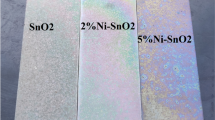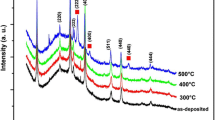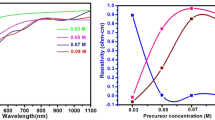Abstract
Nanocrystalline (NC) tin dioxide thin films have been synthesized via sol–gel spin coating method. The sol solution produces thin films that suffer from cracking at room temperature and at different annealing temperatures. Hence, the determination of the smallest value of glycerin is necessary to solve the cracking problem. Glycerin was added to the sol solutions with different volume ratios (0:1, 1:12, 1:8) at low temperature to enhance film porosity and to eliminate cracks. Temperature affects on the characteristics of NC SnO2 thin films, particularly particle size where the crystallization of SnO2 thin films obtained after annealing at 400 °C is a NC tetragonal rutile structure. With the increase of annealing temperature the crystallinity has enhanced, the crystallite size increased, and it was observed that both of the intensity and a blue shift of the A1g phonon peak increased at constant volume ratio of glycerin. Hence, these results indicated that (1:12) of glycerin volume ratio to sol solution volume ratio represents the optimum value for the fabrication of SnO2 thin films without cracks.









Similar content being viewed by others
References
A. Dieguez et al., The complete Raman spectrum of nanometric SnO2 particles. J. Appl. Phys. 90(3), 1550–1557 (2001)
M. Aziz, S.S. Abbas, W.R.W. Baharom, Size-controlled synthesis of SnO2 nanoparticles by sol–gel method. Mater. Lett. 91, 31–34 (2013)
J.S. Jeng, The influence of annealing atmosphere on the material properties of sol–gel derived SnO2: Sb films before and after annealing. Appl. Surf. Sci. 258(16), 5981–5986 (2012)
J. Liu, S. Gong, L. Quan, Z. Deng, H. Liu, D. Zhou, Influences of cooling rate on gas sensitive tin oxide thin films and a model of gradient distributed oxygen vacancies in SnO2 crystallites. Sens. Actuators B 145(2), 657–666 (2010)
S.H. Luo et al., Vacuum electron field emission from SnO2 nanowhiskers synthesized by thermal evaporation. Nanotechnology 15(11), 1424 (2004)
Y. Liu, E. Koep, M. Liu, A highly sensitive and fast-responding SnO2 sensor fabricated by combustion chemical vapor deposition. Chem. Mater. 17(15), 3997–4000 (2005)
X. Liu, J. Iqbal, Z. Wa, B. He, R. Yu, Structure and room-temperature ferromagnetism of Zn-doped SnO2 nanorods prepared by solvothermal method. J. Phys. Chem. C 114(11), 4790–4796 (2010)
S. Chacko, M.J. Bushiri, V.K. Vaidyan, Photoluminescence studies of spray pyrolytically grown nanostructured tin oxide semiconductor thin films on glass substrates. J. Phys. D Appl. Phys. 39(21), 4540 (2006)
M.A. Gubbins, V. Casey, S.B. Newcomb, Nanostructural characterisation of SnO2 thin films prepared by reactive rf magnetron sputtering of tin. Thin Solid Films 405(1), 270–275 (2002)
S. Gnanam, V. Rajendran, Luminescence properties of EG-assisted SnO2 nanoparticles by sol–gel process. Dig. J. Nanomater. Biostruct. 5(3), 699–704 (2010)
H. Köse, A.O. Aydin, H. Akbulut, Sol–gel synthesis of nanostructured SnO2 thin film anodes for Li-ion batteries. Acta Phys. Pol. A 121(1), 227–229 (2012)
S. Gong, J. Liu, J. Xia, L. Quan, H. Liu, Gas sensing characteristics of SnO2 thin films and analyses of sensor response by the gas diffusion theory. Mater. Sci. Eng. B 164(2), 85–90 (2009)
R. Adnan, N.A. Rohana, I.A. Rahman, Synthesis and characterization of high surface area tin oxide nanoparticles via the sol–gel method as a catalyst for the hydrogenation of styrene. J. Chin. Chem. Soc. 57(2), 222–229 (2010)
Y. Li, W. Yin, R. Deng, R. Chen, J. Chen, Q. Yan, Realizing a SnO2-based ultraviolet light-emitting diode via breaking the dipole-forbidden rule. NPG Asia Mater. 4(11), e30 (2012)
G. Sakai, N.S. Baik, N. Miura, N. Yamazoe, Gas sensing properties of tin oxide thin films fabricated from hydrothermally treated nanoparticles: dependence of CO and H2 response on film thickness. Sens. Actuators B 77(1), 116–121 (2001)
C. Ke, W. Zhu, J.S. Pun, Z. Yang, Annealing temperature dependent oxygen vacancy behavior in SnO2 thin films fabricated by pulsed laser deposition. Curr. Appl. Phys. 11(3), S306–S309 (2011)
L.D. Khanh, N.T. Binh, L.T. Binh, N.N. Liong, SnO2 nanostructures synthesized by using a thermal evaporation method. J. Korean Phys. Soc. 52, 1689–1692 (2008)
P. Lian, X. Zhu, S. Liang, Z. Li, W. Yang, H. Wang, High reversible capacity of SnO2 graphene nanocomposite as an anode material for lithium-ion batteries. Electrochim. Acta 56(12), 4532–4539 (2011)
M. Ristić, M. Ivanda, S. Popović, S. Musić, Dependence of nanocrystalline SnO2 particle size on synthesis route. J. Non-Cryst. Solids 303(2), 270–280 (2002)
Acknowledgments
This work was conducted under Research University (RU) Grant: 203/PFIZIK/6711197 the support from Universiti Sains Malaysia gratefully acknowledged.
Author information
Authors and Affiliations
Corresponding author
Rights and permissions
About this article
Cite this article
Kadhim, I.H., Abu Hassan, H. Effects of glycerin volume ratios and annealing temperature on the characteristics of nanocrystalline tin dioxide thin films. J Mater Sci: Mater Electron 26, 3417–3426 (2015). https://doi.org/10.1007/s10854-015-2851-4
Received:
Accepted:
Published:
Issue Date:
DOI: https://doi.org/10.1007/s10854-015-2851-4




